Impact of Social Determinants of Health: An Essay Analysis
VerifiedAdded on 2021/11/01
|5
|969
|82
Essay
AI Summary
This essay delves into the multifaceted relationship between social determinants of health and various societal aspects. It examines how disease can be considered an economic issue, emphasizing the impact on productivity and utility. The essay explores the direct and indirect effects of HIV/AIDS on an individual's economic status, highlighting the reduction in labor productivity and increased healthcare burdens. It further discusses the costs of inaction concerning social determinants in Australia, including health inequity and economic outcomes. The impacts of inequalities in social determinants are analyzed, showing their consequences on physical and mental health, educational attainment, and housing. The essay uses references to support its arguments, providing a comprehensive overview of the subject.
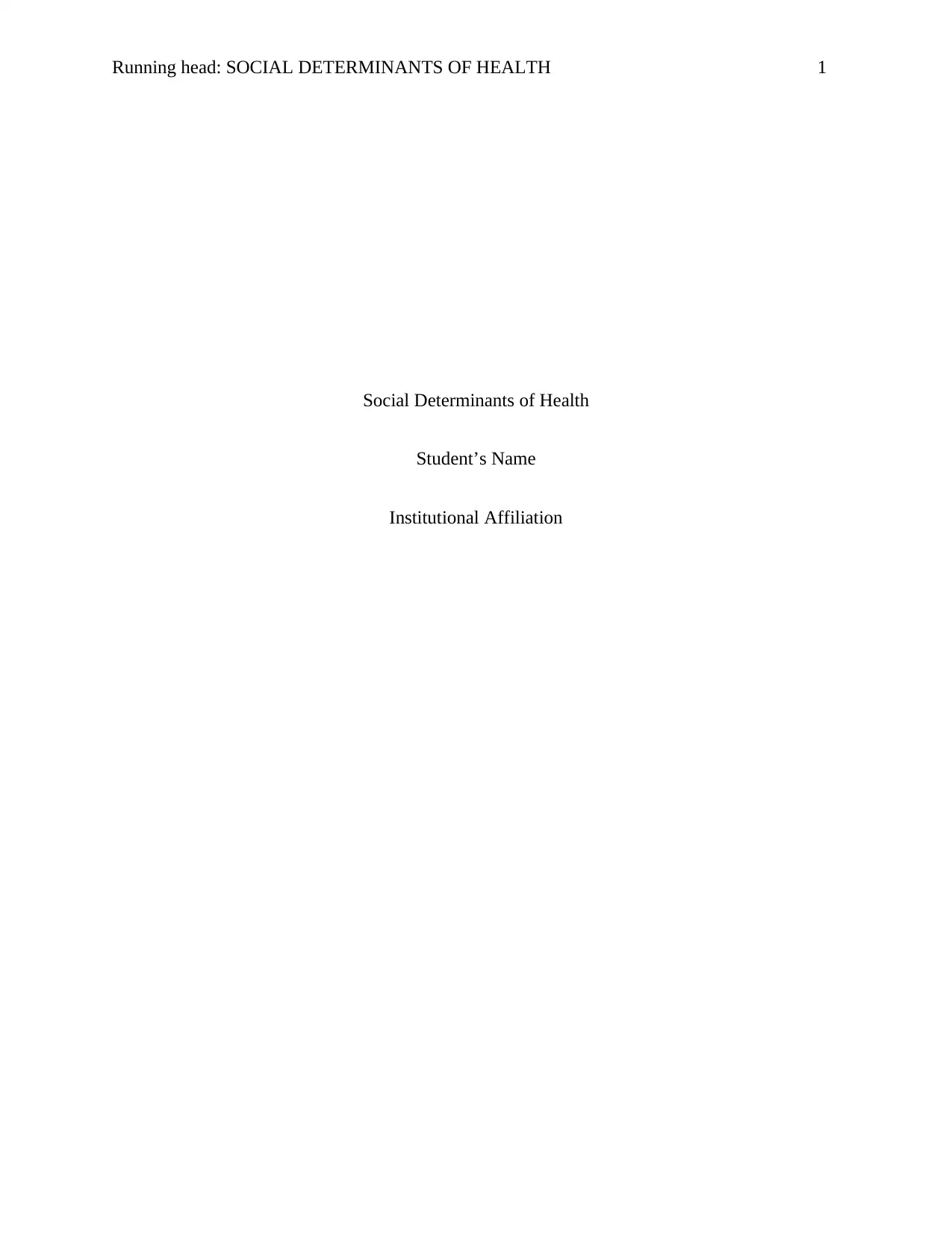
Running head: SOCIAL DETERMINANTS OF HEALTH 1
Social Determinants of Health
Student’s Name
Institutional Affiliation
Social Determinants of Health
Student’s Name
Institutional Affiliation
Paraphrase This Document
Need a fresh take? Get an instant paraphrase of this document with our AI Paraphraser
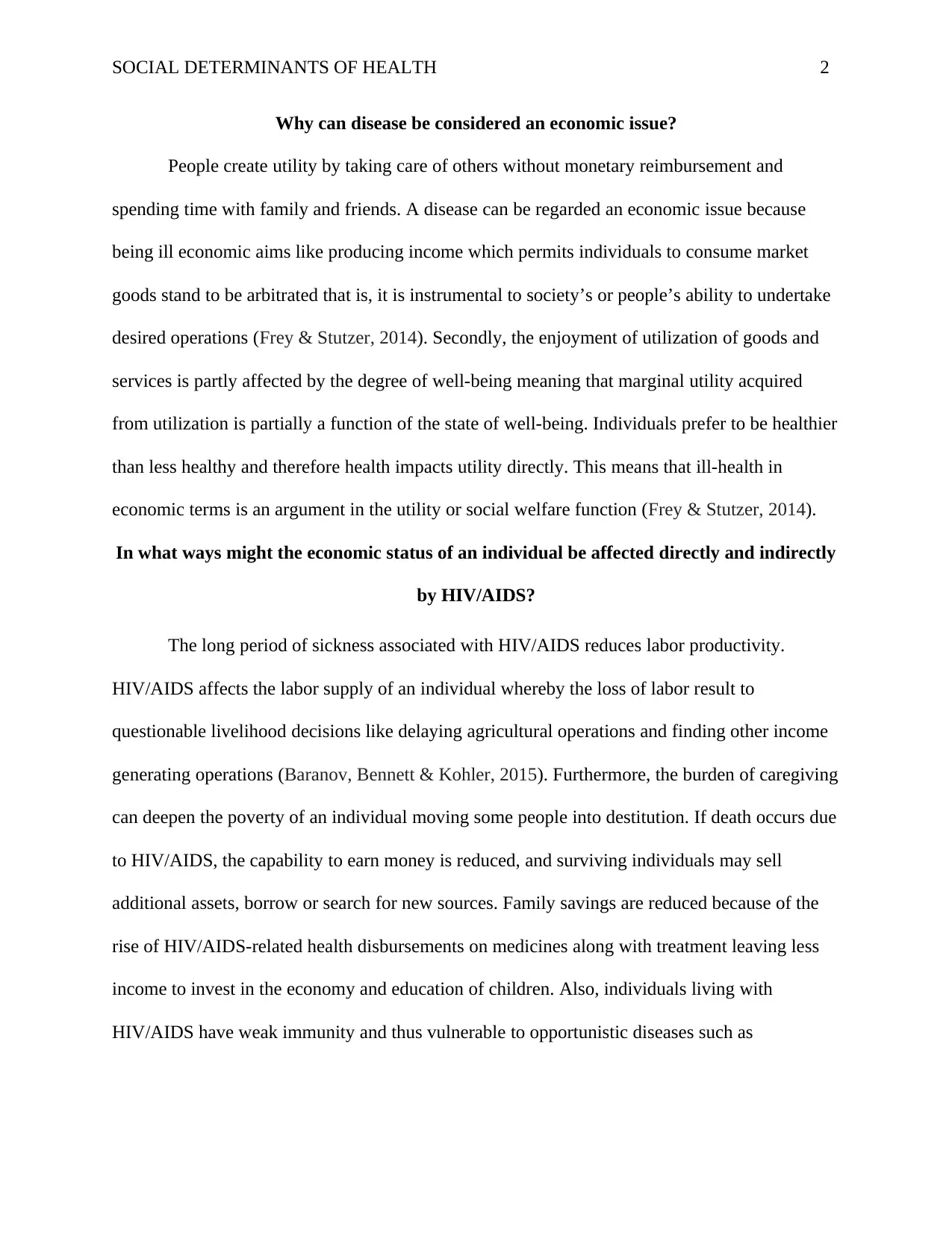
SOCIAL DETERMINANTS OF HEALTH 2
Why can disease be considered an economic issue?
People create utility by taking care of others without monetary reimbursement and
spending time with family and friends. A disease can be regarded an economic issue because
being ill economic aims like producing income which permits individuals to consume market
goods stand to be arbitrated that is, it is instrumental to society’s or people’s ability to undertake
desired operations (Frey & Stutzer, 2014). Secondly, the enjoyment of utilization of goods and
services is partly affected by the degree of well-being meaning that marginal utility acquired
from utilization is partially a function of the state of well-being. Individuals prefer to be healthier
than less healthy and therefore health impacts utility directly. This means that ill-health in
economic terms is an argument in the utility or social welfare function (Frey & Stutzer, 2014).
In what ways might the economic status of an individual be affected directly and indirectly
by HIV/AIDS?
The long period of sickness associated with HIV/AIDS reduces labor productivity.
HIV/AIDS affects the labor supply of an individual whereby the loss of labor result to
questionable livelihood decisions like delaying agricultural operations and finding other income
generating operations (Baranov, Bennett & Kohler, 2015). Furthermore, the burden of caregiving
can deepen the poverty of an individual moving some people into destitution. If death occurs due
to HIV/AIDS, the capability to earn money is reduced, and surviving individuals may sell
additional assets, borrow or search for new sources. Family savings are reduced because of the
rise of HIV/AIDS-related health disbursements on medicines along with treatment leaving less
income to invest in the economy and education of children. Also, individuals living with
HIV/AIDS have weak immunity and thus vulnerable to opportunistic diseases such as
Why can disease be considered an economic issue?
People create utility by taking care of others without monetary reimbursement and
spending time with family and friends. A disease can be regarded an economic issue because
being ill economic aims like producing income which permits individuals to consume market
goods stand to be arbitrated that is, it is instrumental to society’s or people’s ability to undertake
desired operations (Frey & Stutzer, 2014). Secondly, the enjoyment of utilization of goods and
services is partly affected by the degree of well-being meaning that marginal utility acquired
from utilization is partially a function of the state of well-being. Individuals prefer to be healthier
than less healthy and therefore health impacts utility directly. This means that ill-health in
economic terms is an argument in the utility or social welfare function (Frey & Stutzer, 2014).
In what ways might the economic status of an individual be affected directly and indirectly
by HIV/AIDS?
The long period of sickness associated with HIV/AIDS reduces labor productivity.
HIV/AIDS affects the labor supply of an individual whereby the loss of labor result to
questionable livelihood decisions like delaying agricultural operations and finding other income
generating operations (Baranov, Bennett & Kohler, 2015). Furthermore, the burden of caregiving
can deepen the poverty of an individual moving some people into destitution. If death occurs due
to HIV/AIDS, the capability to earn money is reduced, and surviving individuals may sell
additional assets, borrow or search for new sources. Family savings are reduced because of the
rise of HIV/AIDS-related health disbursements on medicines along with treatment leaving less
income to invest in the economy and education of children. Also, individuals living with
HIV/AIDS have weak immunity and thus vulnerable to opportunistic diseases such as
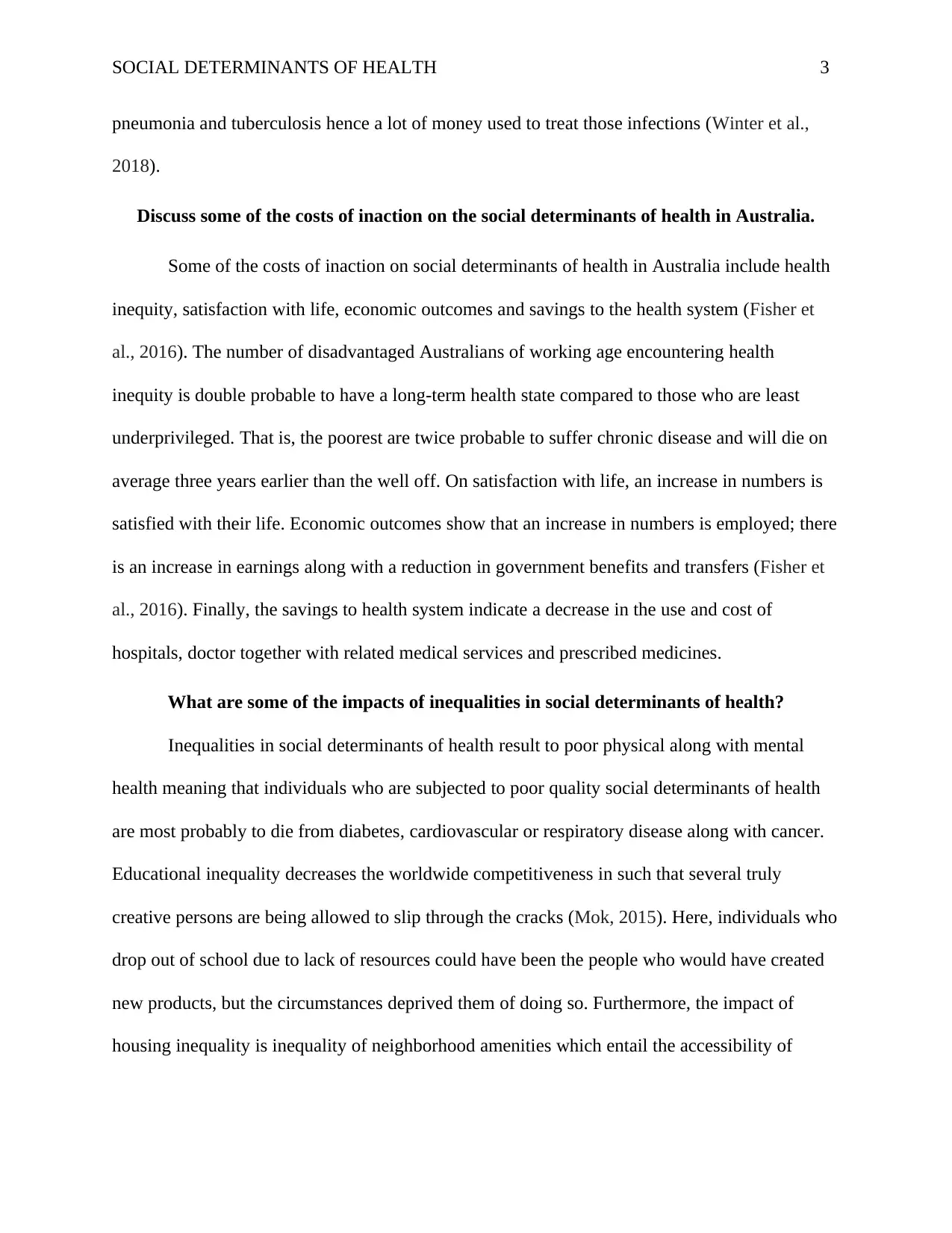
SOCIAL DETERMINANTS OF HEALTH 3
pneumonia and tuberculosis hence a lot of money used to treat those infections (Winter et al.,
2018).
Discuss some of the costs of inaction on the social determinants of health in Australia.
Some of the costs of inaction on social determinants of health in Australia include health
inequity, satisfaction with life, economic outcomes and savings to the health system (Fisher et
al., 2016). The number of disadvantaged Australians of working age encountering health
inequity is double probable to have a long-term health state compared to those who are least
underprivileged. That is, the poorest are twice probable to suffer chronic disease and will die on
average three years earlier than the well off. On satisfaction with life, an increase in numbers is
satisfied with their life. Economic outcomes show that an increase in numbers is employed; there
is an increase in earnings along with a reduction in government benefits and transfers (Fisher et
al., 2016). Finally, the savings to health system indicate a decrease in the use and cost of
hospitals, doctor together with related medical services and prescribed medicines.
What are some of the impacts of inequalities in social determinants of health?
Inequalities in social determinants of health result to poor physical along with mental
health meaning that individuals who are subjected to poor quality social determinants of health
are most probably to die from diabetes, cardiovascular or respiratory disease along with cancer.
Educational inequality decreases the worldwide competitiveness in such that several truly
creative persons are being allowed to slip through the cracks (Mok, 2015). Here, individuals who
drop out of school due to lack of resources could have been the people who would have created
new products, but the circumstances deprived them of doing so. Furthermore, the impact of
housing inequality is inequality of neighborhood amenities which entail the accessibility of
pneumonia and tuberculosis hence a lot of money used to treat those infections (Winter et al.,
2018).
Discuss some of the costs of inaction on the social determinants of health in Australia.
Some of the costs of inaction on social determinants of health in Australia include health
inequity, satisfaction with life, economic outcomes and savings to the health system (Fisher et
al., 2016). The number of disadvantaged Australians of working age encountering health
inequity is double probable to have a long-term health state compared to those who are least
underprivileged. That is, the poorest are twice probable to suffer chronic disease and will die on
average three years earlier than the well off. On satisfaction with life, an increase in numbers is
satisfied with their life. Economic outcomes show that an increase in numbers is employed; there
is an increase in earnings along with a reduction in government benefits and transfers (Fisher et
al., 2016). Finally, the savings to health system indicate a decrease in the use and cost of
hospitals, doctor together with related medical services and prescribed medicines.
What are some of the impacts of inequalities in social determinants of health?
Inequalities in social determinants of health result to poor physical along with mental
health meaning that individuals who are subjected to poor quality social determinants of health
are most probably to die from diabetes, cardiovascular or respiratory disease along with cancer.
Educational inequality decreases the worldwide competitiveness in such that several truly
creative persons are being allowed to slip through the cracks (Mok, 2015). Here, individuals who
drop out of school due to lack of resources could have been the people who would have created
new products, but the circumstances deprived them of doing so. Furthermore, the impact of
housing inequality is inequality of neighborhood amenities which entail the accessibility of
⊘ This is a preview!⊘
Do you want full access?
Subscribe today to unlock all pages.

Trusted by 1+ million students worldwide
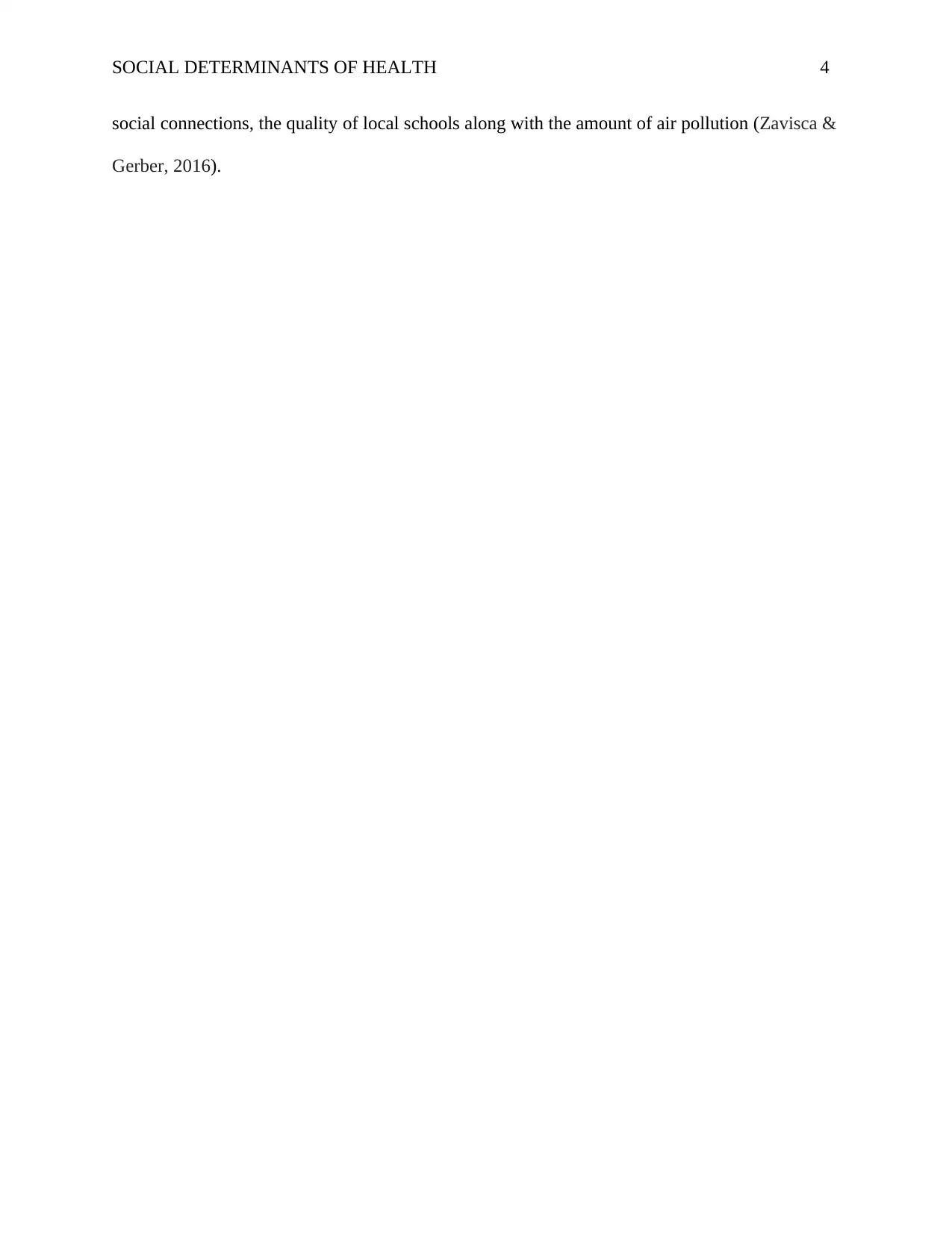
SOCIAL DETERMINANTS OF HEALTH 4
social connections, the quality of local schools along with the amount of air pollution (Zavisca &
Gerber, 2016).
social connections, the quality of local schools along with the amount of air pollution (Zavisca &
Gerber, 2016).
Paraphrase This Document
Need a fresh take? Get an instant paraphrase of this document with our AI Paraphraser
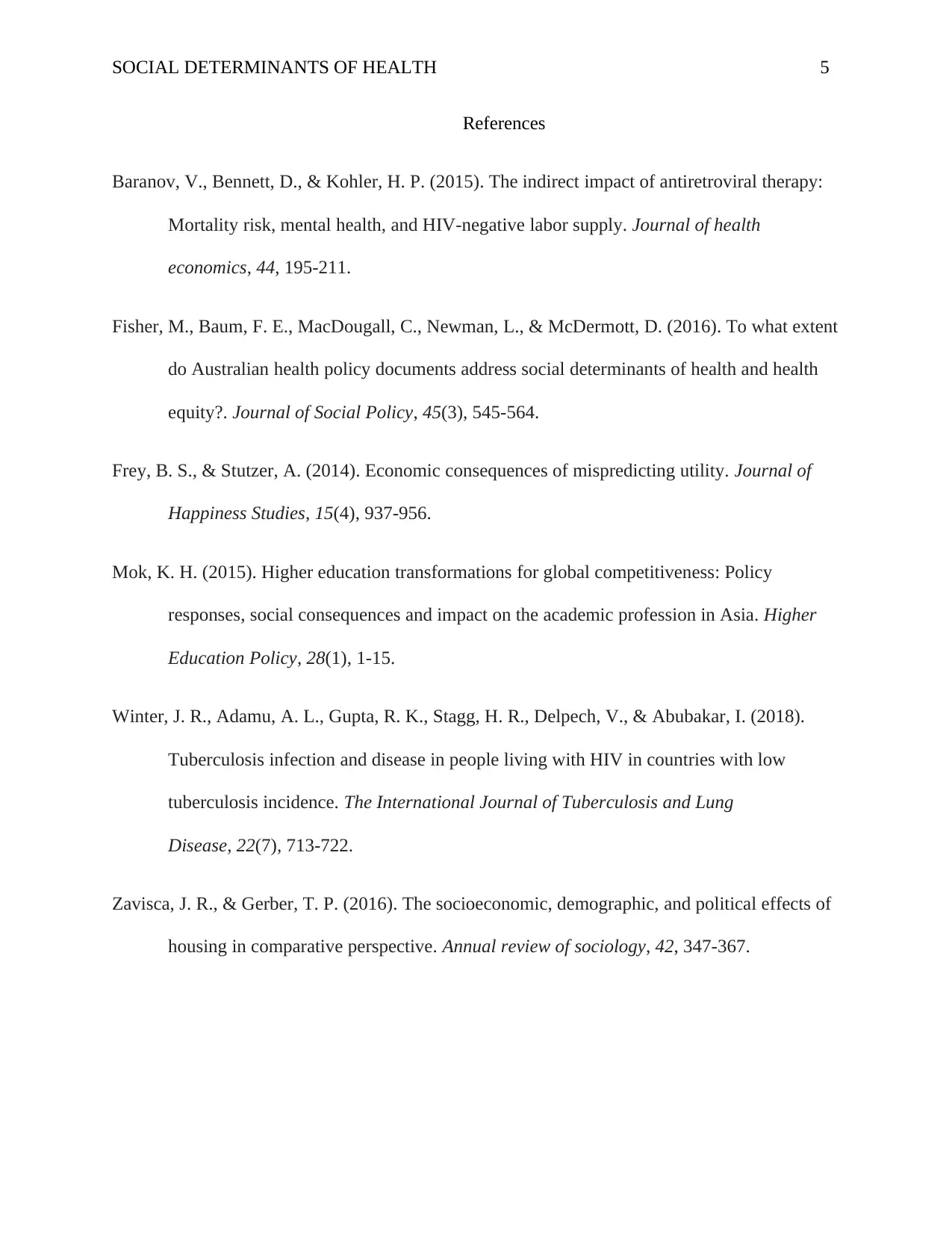
SOCIAL DETERMINANTS OF HEALTH 5
References
Baranov, V., Bennett, D., & Kohler, H. P. (2015). The indirect impact of antiretroviral therapy:
Mortality risk, mental health, and HIV-negative labor supply. Journal of health
economics, 44, 195-211.
Fisher, M., Baum, F. E., MacDougall, C., Newman, L., & McDermott, D. (2016). To what extent
do Australian health policy documents address social determinants of health and health
equity?. Journal of Social Policy, 45(3), 545-564.
Frey, B. S., & Stutzer, A. (2014). Economic consequences of mispredicting utility. Journal of
Happiness Studies, 15(4), 937-956.
Mok, K. H. (2015). Higher education transformations for global competitiveness: Policy
responses, social consequences and impact on the academic profession in Asia. Higher
Education Policy, 28(1), 1-15.
Winter, J. R., Adamu, A. L., Gupta, R. K., Stagg, H. R., Delpech, V., & Abubakar, I. (2018).
Tuberculosis infection and disease in people living with HIV in countries with low
tuberculosis incidence. The International Journal of Tuberculosis and Lung
Disease, 22(7), 713-722.
Zavisca, J. R., & Gerber, T. P. (2016). The socioeconomic, demographic, and political effects of
housing in comparative perspective. Annual review of sociology, 42, 347-367.
References
Baranov, V., Bennett, D., & Kohler, H. P. (2015). The indirect impact of antiretroviral therapy:
Mortality risk, mental health, and HIV-negative labor supply. Journal of health
economics, 44, 195-211.
Fisher, M., Baum, F. E., MacDougall, C., Newman, L., & McDermott, D. (2016). To what extent
do Australian health policy documents address social determinants of health and health
equity?. Journal of Social Policy, 45(3), 545-564.
Frey, B. S., & Stutzer, A. (2014). Economic consequences of mispredicting utility. Journal of
Happiness Studies, 15(4), 937-956.
Mok, K. H. (2015). Higher education transformations for global competitiveness: Policy
responses, social consequences and impact on the academic profession in Asia. Higher
Education Policy, 28(1), 1-15.
Winter, J. R., Adamu, A. L., Gupta, R. K., Stagg, H. R., Delpech, V., & Abubakar, I. (2018).
Tuberculosis infection and disease in people living with HIV in countries with low
tuberculosis incidence. The International Journal of Tuberculosis and Lung
Disease, 22(7), 713-722.
Zavisca, J. R., & Gerber, T. P. (2016). The socioeconomic, demographic, and political effects of
housing in comparative perspective. Annual review of sociology, 42, 347-367.
1 out of 5
Related Documents
Your All-in-One AI-Powered Toolkit for Academic Success.
+13062052269
info@desklib.com
Available 24*7 on WhatsApp / Email
![[object Object]](/_next/static/media/star-bottom.7253800d.svg)
Unlock your academic potential
Copyright © 2020–2025 A2Z Services. All Rights Reserved. Developed and managed by ZUCOL.





